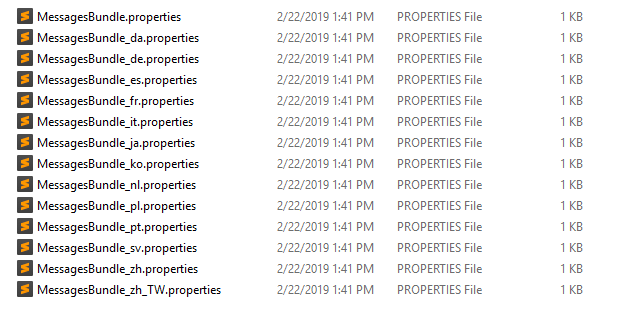Strategy ONE
Internationalization (i18n) of the React Format Panel
This feature is available starting in MicroStrategy 2021 Update 3.
There are two approaches to displaying translated text in the Format panel based on user location or settings:
Use Existing Translations
If the translated text exists in another visualization and you have direct access to the code, it is possible to use the same translated text. The important thing to remember is the context of the text. If the context of the existing translated text is different, it is better to create a custom translation. The structure of the code is shown below.
{ desc: <descId>, name: <defaultName> }
descId The ID of the translated text.
defaultName The name used to identify the text. If descId is not defined, the name is used by default.
The example below shows how to implement translations for a text component:
{
tagName: "Text",
text: { desc: 9738, name: "Area" }
}Add New Custom Translations
The table below lists all languages supported by custom visualizations.
| Language |
Language Code |
Country Code |
|---|---|---|
| Chinese (Simplified) | zh | CN |
| Chinese (Traditional) | zh |
TW |
| Danish (Denmark) | da | DK |
| Deutsch | de |
DE |
| Dutch (Netherlands) | nl | NL |
| English (UK) | en |
GB |
| English (US) | en | US |
| French (Belgium) | fr |
BE |
| French (France) | fr | FR |
| French (Switzerland) | fr |
CH |
| German (Switzerland) | de | CH |
| Italian (Italy) | it |
IT |
| Italian (Switzerland) | it | CH |
|
Japanese |
ja |
JP |
| Korean | ko | KR |
|
Polish |
pl |
PL |
| Portuguese (Brazil) | pt | sBR |
|
Russian |
ru |
RU |
| Spanish (Spain) | es | ES |
|
Swedish (Sweden) |
sv |
SE |
Follow the steps below to add new custom translated text.
-
Create the
MessagesBundle*.propertiesfiles for all languages to be supported. The naming conventions for the files are shown below.-
MessagesBundle_(Language code)_(Country code).properties
-
MessagesBundle_(Language code).properties
-
MessagesBundle.properties
Let's use an example to explain the logic. To support English (UK):
-
The plugin attempts to locate
MessagesBundle_en_GB.properties. If the file exists, the localized string is used. -
If
MessagesBundle_en_GB.propertiesdoes not exist, the plugin looks forMessagesBundle_en.properties. If the file exists, the localized string is used -
If
MessagesBundle_en.propertiesdoes not exist, the plugin looks forMessagesBundle.properties. If the file exists, the localized string is used.
If there is no proper file provided, the default text introduced in the code is used. If there is text without a reference to a corresponding translation, it appears in the dashboard surrounded by asterisks (for example, *Attribute*).
For the sample plugin there is no need to create all the files from scratch. All fully prepared files can be found under
SampleViz/i18n. The only requirement is to copy the files from this location toYourPluginFolder/WEB-INF/classes/resources. -
-
To add new i18n strings, create
MessagesBundlefiles underYourPluginFolder/WEB-INF/classes/resources, if they do not exist.
-
Add all strings in the correct format to each of the
MessagesBundle*.propertiesfiles.Copy<prefix>.<string_id>=<string_content>prefixDifferentiates the strings used in this custom visualizations from others. Follow standard naming conventions by using the custom visualization name here.string_idThe ID used to identify the string. The ID should be unique within a custom visualization. Follow standard naming conventions by using incremental numbers.string_contentThe localized string for each language.The example below uses the sample plugin.
CopySampleViz.10=Attribute
SampleViz.11=Show attribute
SampleViz.12=Metric
SampleViz.13=Show metric -
Restart the Tomcat Web server.
-
The
mstrmojo.requiresDescsWPrefix()function is then used to load the translations. Add unique identifiers to this function inside the mainvisName.jsfile, wherevisNameis the name of the visualization. Place this function call after any import statements and before theplot()function. This allows the code to run first, so the descriptors are loaded before they are needed. Using mojo style internationalization (as described below) while having unloaded descriptors results in a 100ms request to fetch them. Several of these requests cause a noticeable delay when loading the visualization for the first time.The
mstrmojo.requiresDescsWPrefix()function requires arguments for the prefix name and all used string IDs, as shown below.Copymstrmojo.requiresDescsWPrefix("SampleViz.", 10, 11, 12, 13); -
Add translations to the destination file using the following template.
Copymstrmojo.descP('<prefix>.', '<string_id >', '<string_content>')The example below shows a descriptor usage for a checkbox component.
Copy{
tagName: "Checkbox",
key: PROPERTIES_ENUM.SHOW_ATTRIBUTE,
text: mstrmojo.descP("SampleViz.", "11", "Show attribute"),
},
